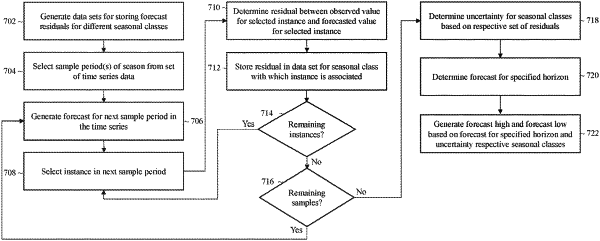| CPC G06T 11/206 (2013.01) [G06F 11/3452 (2013.01); G06F 17/18 (2013.01); G06F 18/2431 (2023.01); G06F 21/55 (2013.01); G06N 20/00 (2019.01); G06Q 10/04 (2013.01); G06Q 10/06 (2013.01); G06Q 10/0631 (2013.01); G06Q 10/1093 (2013.01); G06Q 30/0202 (2013.01); G06T 11/001 (2013.01); G06F 9/505 (2013.01); G06F 2218/12 (2023.01); G06Q 10/06315 (2013.01); H04L 41/0896 (2013.01)] | 19 Claims |

|
17. A system comprising:
one or more hardware processors;
one or more non-transitory computer-readable media storing instructions, which when executed by the one or more hardware processors cause:
decomposing a set of time-series data into a noise signal and a dense signal;
generating, by a machine-learning process, a forecasting model that maps a first set of forecasting components to a first season and a second set of forecasting components to a second season;
wherein the first set of forecasting components defines a first uncertainty interval for the first season based at least in part on recurring sparse features in the noise signal and the second set of forecasting components defines a second uncertainty interval for the second season based at least in part on recurring dense features in the dense signal;
storing residuals for the forecasting model separately by context;
wherein a first set of residuals associated with the recurring sparse features in the noise signal are stored separately from a second set of residuals associated with the recurring dense features in the dense signal;
wherein the first uncertainty interval is computed as a function of the first set of residuals associated with the recurring sparse features in the noise signal and the second uncertainty intervals is computed as a function of the second set of residuals associated with the recurring dense features in the dense signal;
generating, based at least in part on the forecasting model, a forecast for at least once computing resource that projects:
(a) a first range of computing metric values for a first future instance of the first season as a function of the first uncertainty interval; and
(b) a second range of computing metric values for a second future instance of the second season as a function of the second uncertainty interval; and
performing at least one operation on at least one computing system based on at least one of the first range of computing metric values or the second range of computing metric values, wherein the at least one operation comprises deploying additional resources to satisfy anticipated demand on the at least one computing system.
|